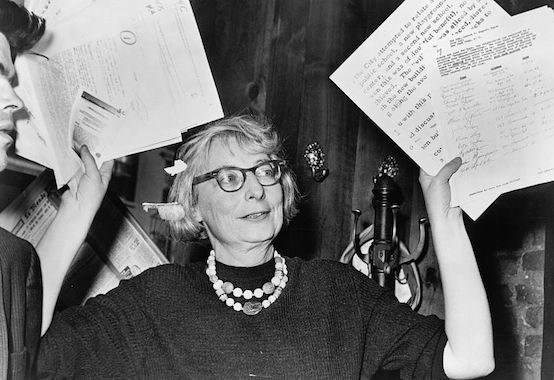100 Years of Jane Jacobs Down, 100 Years to Go

It is difficult to write about the centennial of Jane Jacobs. For one thing, her influence on urbanism is unsurpassed and difficult to understate; for another, everyone has been writing something and so there’s a lot of overlap between pieces.
And yet, for all the encomiums and praise and think pieces in City Lab, Vox, Toronto’s Globe and Mail and even the New York Daily News, it is easy to lose sight of the fact that for all her intellectual influence, very little has changed about the American city and what has changed has been mostly cosmetic.
In the Boston area, for example, outdated zoning and building codes have created a process so complex that only professionals can navigate it and so long that only luxury buildings are profitable. The codes result in structures that encourage driving with parking minimums, setbacks that turn already wide streets into drag strips and use-separation that deadens them further.
And that’s ignoring the great architectural void in America right now: new buildings, even when they’re on the street, have patently horrible interaction with it. We continue to massive, whole block buildings with blank curtain walls, hypertrophic setbacks and useless lawns. As previously noted, Somerville’s Assembly Square development has produced a lot of giant parking garages and little else.
Charleston, South Carolina, has become a poster-child for the New Urbanism by creating restrictive architectural codes and figuring out clever ways to hide parking instead of helping people to become less dependent on it.
Many neighborhoods are still mired in a lack of activity. Downtown Crossing is vibrant during the day and almost deserted at night, Brighton Center, Roslindale and other neighborhoods have the opposite problem. The only people in the South End during the day appear to be dog walkers.
The dualistic level of activity has effectively prevented the development of “sidewalk ballet” streetlife in most neighborhoods, which has made it haerd for them to absorb newcomers. While Boston retains a fairly strong civil society, which can make up for the lack of street-life, those institutions are not attracting or even working to attract the young or newcomers.
Perhaps the only way Jacobs’ ideas have really been applied have been in the development of mixed-use buildings. Just about every new building in Boston, Cambridge and Somerville is mixed-use. However, what this usually means is a small portion of the street frontage goes to a retail use. Often they are tenanted to a chain company even before construction starts and sometimes they’re deed-restricted in an effort to not generate traffic. Unfortunately, the focus on retail ignores the just as important industrial and office uses vital to the health of the city.
Worse still, the lip service paid by officials and planners to Jacobsian ideas can lull citizens and activists into a false sense of security. It’s one thing for the mayor to talk about Vision Zero and mode shift, but Boston is falling behind in its bike commitments and the administration has been indifferent to transit issues.
Where Jacobs’ legacy has truly been transformative has been in her famous battle with Robert Moses. The organization and mobilization of entire neighborhoods to resist being destroyed for suburban motorists helped make today’s revival and renewal of American cities possible. It’s true that it has also contributed to the plague of NIMBY’s, eager to oppose anything and everything with cries of “Save our neighborhood!” but without Freeway Revolt there wouldn’t be much of anything left in Boston to even feel threatened.
The No Boston Olympics movement helped to derail a costly, condescending and absurd attempt to hand over control of the City to a shadowy and corrupt oligarchy, fully prepared to prevent Bostonians’ freedom of movement across their city and access to their parks, as well as using eminent domain to destroy an important business cluster in Widett Circle.
Similarly, residents of Allston have played a major role in keeping the Massachusetts Department of Transportation honest as it tries to rebuild Interstate 90 through the neighborhood. The Allston Interchange Task Force and People’s Pike have fought MassDoT every step of the way to get them to do a project that’s actually acknowledges the fact that this highway is in an urban neighborhood. While a lot of work remains ahead of them, they show no signs of giving up.
Perhaps, though, it’s appropriate that the recovery of our cities from urban renewal is taking so long. Cities are the products of centuries of tradition, economic evolution, and human use. Expecting them to recover instantly makes the same mistake of cataclysmic redevelopment that overthrew them in the first place. That organic tradition cannot be revived all at once: the only way to rebuild the city is to rebuild it brick by brick, building by building.
Matthew M. Robare is a freelance journalist based in Boston and also writes about urbanism and history. This post was originally published on Urban-Liberty.com.
“New Urbs” is supported by a grant from the Richard H. Driehaus foundation.